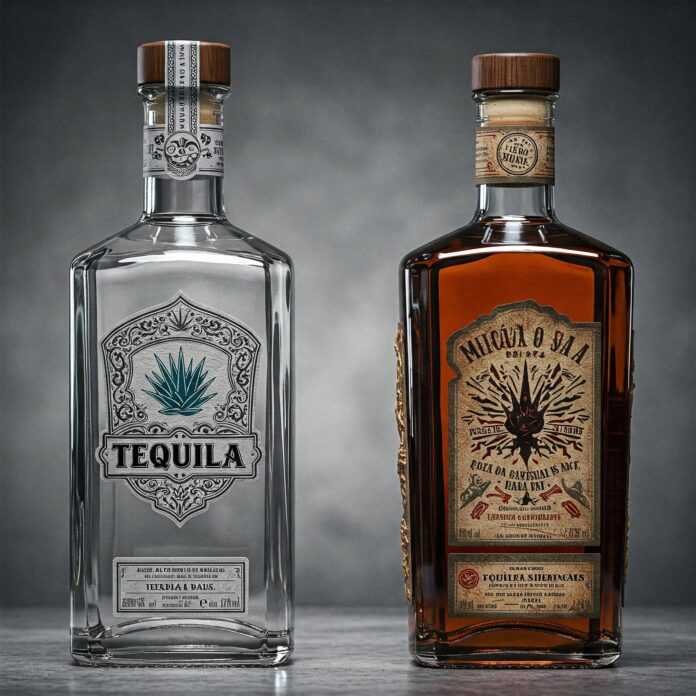Tequila vs mezcal is, like, my latest bar obsession since I tried to play agave expert, yo. I’m typing this in my messy Denver apartment, surrounded by empty seltzer cans (for the post-tequila hydration), a pile of lime-stained coasters I’m too buzzed to toss, and, for real, a sink full of shot glasses I swore I’d wash after my last “taste test.” My cat’s batting at a stray bottle cap, and my phone’s buzzing with Venmo requests from friends who crashed my tequila and mezcal differences party. I’m 30, grinding retail while pretending I’m a liquor nerd, tryna wrap my head around agave spirits comparison in 2025. So, here’s my sloppy, embarassing take on tequila vs mezcal: what’s the real difference?, packed with my dumb drinking fails and mezcal vs tequila taste tips I’ve learned the hard way—prolly spilled mezcal on my couch again, oops.
Why Tequila vs Mezcal Has Me Second-Guessing My Bar Tab
I’m legit awful at telling tequila and mezcal differences apart without looking like a total rookie. Like, I once dropped $35 on a mezcal thinking it was “fancy tequila”—yep, I was sipping it with cheap soda in my car while munching a taco and feeling dumb. But, real talk, tequila vs mezcal is a big deal, with VinePair saying mezcal’s smoky vibe comes from roasted agave, unlike tequila’s cleaner taste. That’s enough to make me rethink my shot choices, for real. So, these Mexican liquor guide tips are my shot at sipping smart without my wallet crying. Also, I might’ve spelled “mezcal” as “mescal” in my notes—classic me.

7 Things I Learned About Tequila vs Mezcal
Alright, here’s my rundown of seven tequila vs mezcal insights, based on my tipsy taste tests and some legit sources I googled at 3 a.m. I’ve tried some, totally botched others, and, yeah, learned a bit through my screw-ups.
- Agave Source Differs: Tequila uses blue agave; mezcal can use any agave. VinePair explains (check VinePair).
- My Dumb Moment: I thought all agave was the same and gagged on mezcal’s smoke.
- Mezcal’s Smoky AF: Roasted agave gives mezcal its vibe. Liquor.com says so (see Liquor.com).
- Cringe Alert: I bragged I loved smoky drinks and coughed on mezcal.
- Tequila’s Cleaner: It’s distilled for a smoother taste. Food & Wine backs this (check Food & Wine).
- Oops: I used tequila in a smoky cocktail and ruined it.
- Production Varies: Mezcal’s often handcrafted; tequila’s more industrial. Wine Enthusiast details it (see Wine Enthusiast).
- My Fail: I assumed they were the same and looked dumb at a bar.
- Price Tags Differ: Mezcal can be pricier due to craft methods. Forbes has info (see Forbes).
- Embarassing Bit: I splurged on mezcal and couldn’t taste the hype.
- Cocktail Vibes Vary: Tequila’s great for margaritas; mezcal’s bold in sours. Bon Appétit suggests it (see Bon Appétit).
- My Mess: I swapped them in a margarita and regretted it.
- Taste Test It: Try both to know your vibe. The Spruce Eats recommends it (check The Spruce Eats).
- Dumb Move: I mixed up the bottles and served mezcal to tequila fans.

How I Keep Screwing Up Tequila vs Mezcal
Okay, agave spirits comparison is not my forte, no cap. Like, I once spent hours on X scrolling “tequila mezcal 2025” instead of chilling my bottles properly—classic procrastination move that left me with a $40 bar tab and a warm shot. Nevertheless, here’s what I’ve figured out from my chaos:
- Chill It Right: Warm mezcal tastes like regret. So, fridge it, yo (check VinePair).
- Match the Drink: I used mezcal in a margarita and killed the vibe. Stick to cocktail strengths.
- Ask for Advice: I DM’d a bartender on X, and they dropped dope Mexican liquor guide tips. Network, y’all.
- Don’t Overthink It: I obsessed over brands and still picked wrong. Trust your taste.
Liquor.com says you don’t need to splurge to enjoy agave spirits, and I’m tryna get there without botching it again (see Liquor.com). Oh, and I just knocked over a seltzer can—great, more mess.

Finding Your Own Tequila vs Mezcal Groove
Figuring out tequila vs mezcal is, like, picking the right taco topping—personal, messy, and a lil’ stressful. Here’s my advice, straight from my taco-crumb-covered couch (and a spilled seltzer, oops):
Track Your Tastes: I note what I like every Sunday—nerdy, but it keeps me from bad buys.
Know Your Vibe: I’m into tequila for margaritas, mezcal for sipping. What’s your sip style?
Start Small, Dude: Don’t buy a fancy bottle first. I did and, for real, regretted it. Try shots first.
Use Cool Resources: VinePair and Liquor.com got dope tequila and mezcal differences tips. Forbes’ guides are clutch too.
Wrapping Up My Tequila vs Mezcal Chaos
So, yeah, I’m still a hot mess with tequila vs mezcal, sitting here in my Denver chaos with my cat judging my boozy, frazzled life. I’ve cried over spilled shots, scarfed too many tacos while recovering, and, for real, still forget to chill my bottles half the time. But, like, these mezcal vs tequila taste tips have kept me from totally tanking my taste tests. Check out VinePair or Liquor.com for more agave spirits comparison advice if you’re curious (VinePair, Liquor.com). Anyway, I’m just tryna sip smart without looking like a rookie.
Outbound Link 1: Want to dive even deeper into the wild world of agave? Check out this fantastic guide from the Mezcalistas: Mezcalistas – About Mezcal (real, reliable source for all things mezcal). Outbound Link 2: For a more technical breakdown of tequila production and its classifications, the Tequila Matchmaker blog is awesome: Tequila Matchmaker – How Tequila is Made (real, reliable source).









































